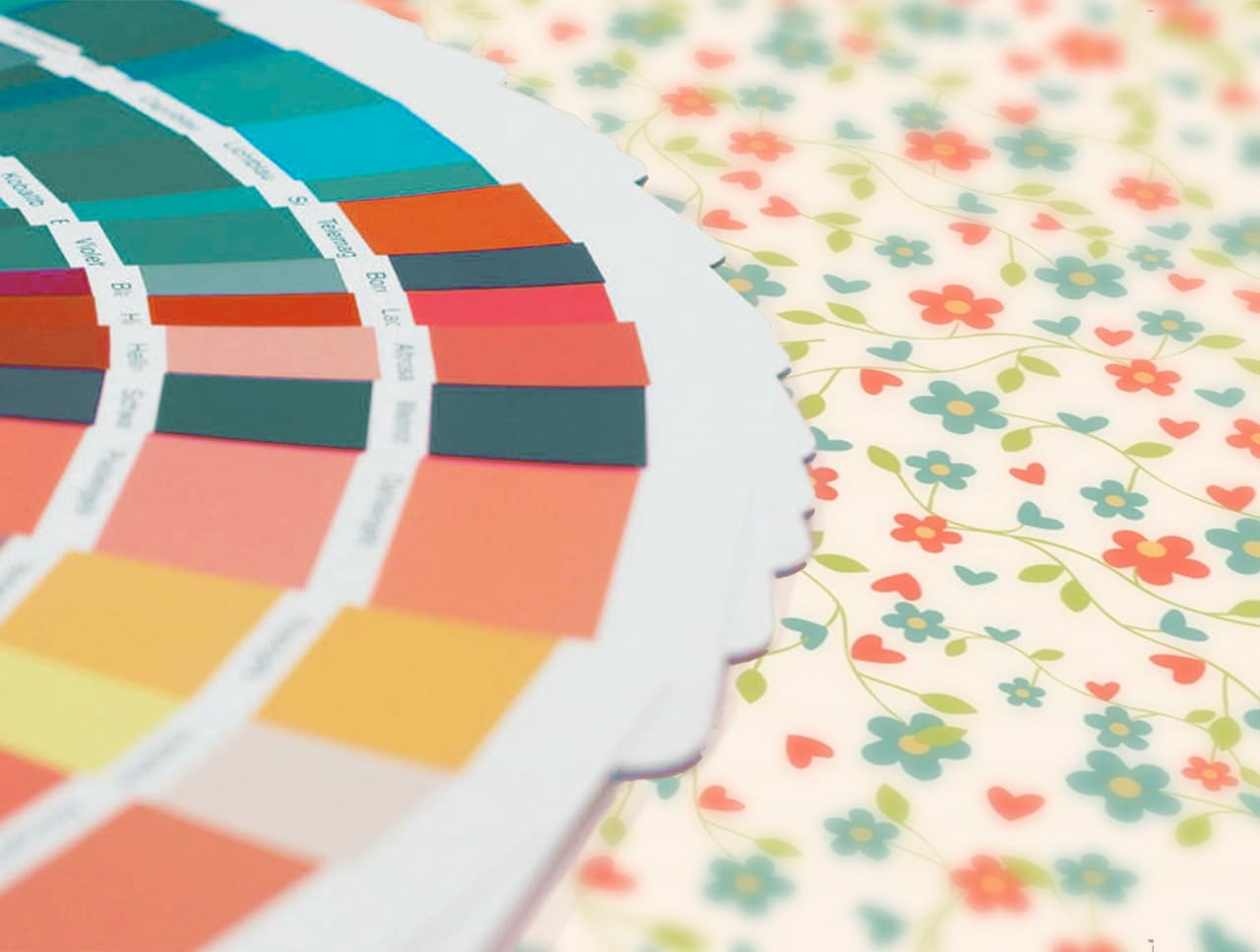In every printing application, color is always a primary concern. Entrepreneurs, interior designers and Fortune 500 companies want consistency of their brand in print. Thanks to color systems like Pantone, this is an achievable goal. By working with a specific color on a pre-selected paper stock, the process is quite straightforward.
When it comes to recreating and reproducing wallpaper, there are more variables to consider from a printing and design aspect. We’ll explore some of these challenges in this article, tackling some of the most frequent questions we deal with in our restorations of historic prints.
Variable #1: How Is The Color Being Printed?
There are a number of ways that a printer might recreate a vintage wallpaper roll from a sample. The techniques employed are often a determining factor in how well colors can be replicated. Not all processes work the same, or use the same type of inks.
Surface Printing
Surface printing typically uses oil-based inks that are thick and highly pigmented. These inks are applied to the surface of the material, rather than being absorbed. This method is famous for producing rich, deep colors that stand the test of time. This feature comes at the cost of precision for color-critical applications. Despite their resilience, they can also be prone to cracking or fading over time.
Block Printing
Block printing often uses water-based inks that are applied to the surface of the printing block and transferred onto the paper or substrate. These inks can be highly pigmented and can produce vivid, vibrant colors. They are also often easy to work with and can be blended to create custom colors or gradients. However, block printing inks may not be as precise other types of inks, and are prone to bleeding or smudging if not applied carefully.
Gravure Printing
Gravure printing: Gravure printing typically uses solvent-based inks that are applied to the printing cylinder and transferred onto the paper or substrate. These inks are often highly pigmented and can produce consistent, precise colors with a smooth, even finish. They are also often resistant to fading or wear over time. However, gravure printing inks can be expensive and difficult to work with, requiring specialized equipment and expertise.
Flexographic Printing
Flexographic printing often uses water-based inks that are applied to the flexible printing plates and transferred onto the paper or substrate. These inks can be highly pigmented and produce vivid, vibrant colors with good consistency and precision. They are also often quick-drying and easy to handle. However, flexographic printing inks may not be as durable or resistant to wear as some other types of inks, and they can be prone to bleeding or smudging if not applied carefully.
Digital Printing
As our preferred method of wallpaper reproduction, clearly there is some bias here. Not only is this method fast, convenient and consistent but it covers a wide spectrum of color in the CMYK space thanks to UV based inks.
UV ink is cured by ultraviolet light rather than heat, making them ideal for digital printing as they dry quickly and adhere well to a variety of substrates, including paper, vinyl and fabric or canvas. They can also produce vivid, bright colors with great precision and consistency.
Overall, UV inks for digital printing can be a good choice for wallpaper production when high precision and color accuracy are needed, and when a variety of substrates are being used. However, there are limits and edge cases of certain colors or effects that cannot be matched exactly.
Specialty inks, (ie: metallics) are not compatible with this method. It’s also important to note that digital printing allows the paper to absorb the ink, so you don’t get the same tactile finish from more opaque methods like block or surface printing.
All of that said, it is definitely among the most cost effective methods and by far the most flexible in terms of repairing, tweaking or recreating a pattern, which is why it’s our go-to for all large format printing projects.
Variable #2: How Well Can You See Color?
In our years of experience, we’ve learned that color matching can sometimes be a subjective exercise. Certain colors are more difficult to build a consensus on than others. Blues and greens can be particularly tricky. Lighter, less saturated colors are even more hotly contested. Beiges and creams in particular can be very fussy depending on who is reviewing the sample.
This is why a keen eye for color is essential for matching. The printer must be able to identify and match subtle variations in hue, saturation, and brightness to ensure a seamless transition between old and new wallpaper.
This cross-section of color theory, printing technology, and material science is required to produce the most faithful wallpaper replicas, within the acceptable limits of the material and printing methods.
One interesting fact about colors is that the longer you stare at them, the more they skew your color perception. If you stare at a red square for 15-20 seconds and then look at a white surface, you will see green, which is the complimentary, or opposite color of red.
A large part of this process requires the designer to take various pauses, and observe the samples under various lighting scenarios. You definitely don’t want a client signing off on a sample because it looked like a match under flourescent light, only to find out it looks completely off under LEDs or sunlight.
Variable #3: What is the Condition/Complexity of the Original Wallpaper?
In terms of how wallpaper ages, we’ve see everything from mold stains and water damage, to rips, scrapes and rust. Sometimes a part of the wall is faded from sun exposure and any color matching in that area should be done independently. For utmost accuracy, you’ll want to ensure the original sample is free from discoloration and consistent throughout the pattern.
Another relevant factor in this equation is the number of colors. Many times there are a greater number of them than people see at first glance. It’s very typical to have 3-5 different tints and shade of a given hue.
The more colors that need to be matched, the more challenging this task becomes. You’ll definitely want press samples with color swatches, reviewed under proper lighting conditions as discussed above.
Variable #4: How Perfect Does the Match Need to Be?
Wallpaper replication is often fixated on accuracy, many people want a faithful rendition and are willing to go through the exttra steps to ensure the closest possible match. But there are also those who are more concerned with the content or design itsef being preserved, for them color is either a secondary consideration, or they have their own ideas of how to modify/change a vintage palette to match their modern decor.
In addition to technical expertise, a keen eye for color is essential for recreating custom wallpaper designs where accuracy is a priority. The printer must be able to identify and match subtle variations in hue, saturation, and brightness to ensure a seamless transition between old and new wallpaper.
The Process
Accurate color reproduction for wallpaper reproduction requires a thorough understanding of color theory and how it relates to ink, paper, and printing technology. Only with this expertise can professionals ensure that the colors in the wallpaper design are reproduced accurately and beautifully.
Here’s a final breakdown of how this process works, from a printing and design perspective:
-
A printing specialist must analyze the colors in the sample or image to determine the exact color values and the printing process required to achieve those colors. There are a wealth of tools and techniques that can accomplish this. We tend to lean heavily on standards like Pantone, Benjamin Moore along with our own proprietary software.
-
A designer must digitally recreate the sample, removing all blemishes or signs of age, and in many cases recreating lost sections of a pattern. WIth the core pattern repaired the designer can then begin the process of color separation, where each individual hue is traced and isolated into separate layers in order to provide absolute control over each color.
-
Depending on the printing technology used, the printer may need to adjust the color profiles, ink types, and printing settings to ensure accurate color reproduction. This requires a deep understanding of color theory and how colors interact with different materials and printing processes. Color theory involves the study of how colors interact with each other and how they can be combined to create different hues, shades, and tones. This understanding is essential in determining how to reproduce a specific color or color scheme accurately.
-
The printer must also take into account the substrate or material on which the wallpaper will be printed, as this can affect color accuracy. For example, printing on a textured or non-white substrate can alter the appearance of colors.
-
A press proof is always provided, with the same ink and material of the final product so the client sees exactly what they are purchasing, and can make adjustments if needed. Once they sign off on a proof, it concludes the color matching aspect of the recreation process. If not then new proofs are printed until a consensus and authorization is reached.
The Results
The accuracy of a wallpaper replication will depend greatly on all of these factors, but most importantly it depends on your own creative vision and how well you’re able to communicate them to your printing team. Hopefully this article has provided some insight into this highly specialized process.
The Plug
If you’re in the market for a vintage wallpaper replica and want to speak to folks who have two decades of experience and are well versed on the topic, give us a call @ 212.619.5446 or Email Inquiries@FinePrintNYC

